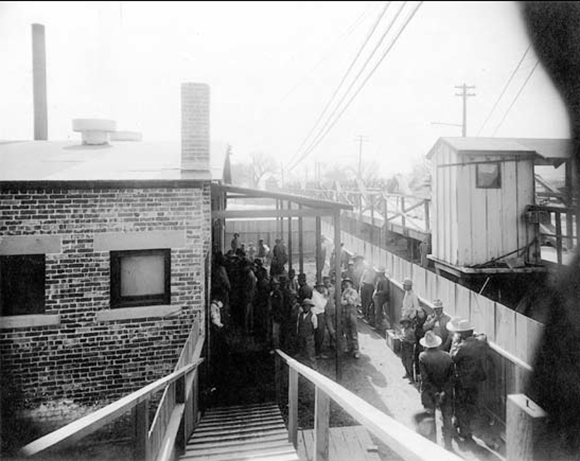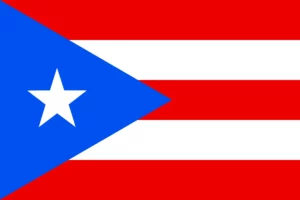Everyone has a hometown but not everyone can say they are proud of their hometown. Despite El Paso’s tumultuous history, the city is one community made of Mexicans, Americans, and Mexican-Americans that come together in times of need, because it is in adversity that the city that I am proud to call my home grows into a family.
103 years ago in El Paso, Texas, the border changed forever. Before 1917, people from El Paso and Juarez could cross the border freely without a passport. Mike Romo was a resident of El Paso and in the book Ringside Seat To A Revolution, he recalls how easy it was to cross. “Coming from Juarez across the Stanton Bridge they never asked you for identification. They never asked you for anything.”1 Then everything changed.
The Immigration Law of 1917 required that immigrants at all points of entry had to have a passport, had to take a literacy test, and had to pay an $8 head tax. At the same time, the US public health services published a manual that outlined the “classes of aliens” that should be excluded from the US. The manual included a list of people that were to be excluded, including homosexual people, chronic alcoholics, polygamist, prostitutes, contract laborers, and most notably imbeciles, idiots, and feeble-minded persons.2 The border was never again the free gateway between two countries that was one community. During these times, delousing centers, built in 1916 on the border, were creating a humiliating process for many Mexicans simply trying to get to work. On January 28, 1917, a girl named Carmelita Torres started a riot that would cement her name in the history for years to come.
Due to deep rooted xenophobia after the Mexican Revolution and the anti-foreigner sentiment coming from the US entering into WWI, the Mexican people were treated horribly as they continued to live their lives crossing to work in the US. In 1916, the mayor of El Paso Tom Lea sent letters to Washington officials for months asking for the ability to quarantine all Mexicans at the border for 10 to 14 days, to make sure they were free of typhus before being allowed into the states. The mayor kept persisting even though he was told by Dr. B. J. Lloyd, the local public health official, that typhus was not a serious menace to the civilian population. Despite this, according to John Burnett, journalist for NPR, Dr. Lloyd echoed the mayor’s racist language and suggested the deployment of delousing centers, stating that he would “cheerfully bathe all the dirty lousy people coming from Mexico.”3 Thus in 1916, the delousing centers were born.3

In these delousing centers, Mexicans were forced to go through a toxic and dehumanizing process. It began in a facility called “the gas room,” where they were forced to strip naked, and hand over their clothes, which were put in steam dryers that would melt their shoes. They had their clothes fumigated with Zyklon B gas, the same chemical used later in Germany to kill millions of people. According to Raquel Reichard, journalist for We are Mitu, the El Paso gas chambers were not just reminiscent of the gas chambers of WWII; they were the inspiration for them. In 1937, a German scientist pushed for Zyklon B to be used in the German gas chambers, citing El Paso’s use of the chemical with pictures as evidence.5
After this, they were inspected for lice even in their pubic hair. If any were found, they would be forced to bathe in a mixture of kerosene and vinegar. They would then be forced to shave their heads. For women such as Carmelita, American soldiers would take pictures of them naked and put them up in local bars in El Paso. After this process, they received a ticket that showed that they were “clean” for eight days; then they would be forced through the process all over again.6

During these humiliating processes, there was also a looming fear of being killed. On March 5, 1916, prisoners in the El Paso City Jail were told to strip naked and douse their clothes in a mixture of gasoline, creosote, and formaldehyde. The prisoners themselves had to go inside a mixture of gasoline, coal oil, and vinegar. Around 3:30 pm, someone struck a match that set the entire jail ablaze. Fifty naked prisoners were caught in the fire, twenty-seven of whom died as a result. Nineteen of the twenty-seven were Mexican citizens, one was an African-American man, and the other seven were homeless Anglo people. This event became known as the Jail House Holocaust. The mayor of El Paso announced that the whole thing was an unavoidable accident, and after an investigation, no one was held liable for the death of twenty-seven people. The El Paso Herald put it nicely: “Apparently no one could be found to fix the blame on the city for the death of 19 Mexicans a few white transients and a negro.” After this incident, every Mexican that crossed the border now carried the fear of being burned to death.7
Finally, in January of 1917, Carmelita had had enough. On the morning of January 28, 1917, Carmelita crossed at the Santa Fe Bridge to El Paso just as she did everyday. The seventeen-year-old girl was a maid who cleaned houses for American families in El Paso. At 7:30 in the morning she was told to get off the trolley she was on to take a gasoline bath. She refused. Instead she got off the street car with thirty other women and protested the humiliating process. Within the hour, two-hundred women joined her and blocked the traffic in the street, and by noon, thousands of people were rioting in the streets. Many of them laid down in front of the tracks of the trolley cars. They yelled and threw rocks at the people who had been humiliating them and filling them with fear every eight days for over a year. Several people were killed. It took two days and many Mexican and American troops to quell the riot, and Carmelita was arrested.8

Carmelita Torres was described by the El Paso Times as an “auburn haired Amazon” that started all this commotion just because a bunch of Mexicans didn’t want to take a bath.9 Other newspapers referred to her as the leader of an anti-American riot.10 Today she is seen as a Latina Rosa Parks. In reality, she was a young woman tired of the injustice she was treated with. Unfortunately, all trace of her was lost after the riot, and most likely she was killed with the others.
Despite her best efforts, the delousing process only got worse. In the next few years, agents added DDT to the fumigation process, spraying the now-banned chemical in the faces and genitals of many Mexicans.11 It wasn’t until the 1960s that the delousing process was recognized as dangerous by public health officials and the practice was ended.
Today there may not be a delousing center in my hometown anymore, but what has been put in its place is an area of separation, where families, migrant workers, and asylum seekers await to be inspected and declared suitable for entry. In a hearing before the subcommittee on border security, the honorable Kathleen M. Rice, a representative from New York, spoke about her trip to El Paso. In El Paso, she met with workers of ICE as well as representatives from The Annunciation House, which is a non profit that helps those seeking asylum. She talks about the hazardous treatment of thousands of asylum seekers in the El Paso Processing Center, which is remarkably similar to the delousing centers of the past.12 This makes me ask the question, are we as a nation simply finding new ways to deny passage to a country founded by immigrants, or are we one day finally going to understand each other and welcome each other as human beings?
- David Romo, Ringside Seat to a Revolution: An Underground Cultural History of El Paso and Juarez, 1893-1923 (Cinco Puntos Press, 2005), 228. ↵
- David Romo, Ringside Seat to a Revolution: An Underground Cultural History of El Paso and Juarez, 1893-1923 (Cinco Puntos Press, 2005), 228-229. ↵
- John Burnett, “1917 Paso-Juarez Bath Riots Recalled,” Weekend Edition Saturday (NPR), January 28, 2006. ↵
- John Burnett, “1917 Paso-Juarez Bath Riots Recalled,” Weekend Edition Saturday (NPR), January 28, 2006. ↵
- Raquel Reichard, “Remembering Carmelita Torres, The Teenage Mexicana Who Started a Riot at the Texas Border,” We are Mitu, August 7, 2019, https://wearemitu.com/things-that-matter/remembering-carmelita-torres-the-teenage-mexicana-who-started-a-riot-at-the-texas-border/. ↵
- Raquel Reichard, “Remembering Carmelita Torres, The Teenage Mexicana Who Started a Riot at the Texas Border,” We are Mitu, August 7, 2019, https://wearemitu.com/things-that-matter/remembering-carmelita-torres-the-teenage-mexicana-who-started-a-riot-at-the-texas-border/. ↵
- David Romo, Ringside Seat to a Revolution: An Underground Cultural History of El Paso and Juarez, 1893-1923 (Cinco Puntos Press, 2005), 226-227. ↵
- David Romo, Ringside Seat to a Revolution: An Underground Cultural History of El Paso and Juarez, 1893-1923 (Cinco Puntos Press, 2005), 225. ↵
- David Romo, Ringside Seat to a Revolution: An Underground Cultural History of El Paso and Juarez, 1893-1923 (Cinco Puntos Press, 2005), 225. ↵
- Raquel Reichard, “Remembering Carmelita Torres, The Teenage Mexicana Who Started a Riot at the Texas Border,” We are Mitu, August 7, 2019, https://wearemitu.com/things-that-matter/remembering-carmelita-torres-the-teenage-mexicana-who-started-a-riot-at-the-texas-border/. ↵
- Raquel Reichard, “Remembering Carmelita Torres, The Teenage Mexicana Who Started a Riot at the Texas Border,” We are Mitu, August 7, 2019, https://wearemitu.com/things-that-matter/remembering-carmelita-torres-the-teenage-mexicana-who-started-a-riot-at-the-texas-border/. ↵
- The Impacts of Trump Policies on Border Communities : Hearing before the Subcommittee on Border Security, Facilitation, and Operations of the Committee on Homeland Security, House of Representatives, One Hundred Sixteenth Congress, First Session, April 30, 2019. 2019. U.S. Government Publishing Office. ↵



59 comments
Bailey Godwin
This article was very interesting and ironic due to the pandemic we are in now. I had limited knowledge on this topic prior to reading this article, however it really caught my attention. Carmelita was such a brave woman and she stood up for what she believed in due to the horrible mistreatment of her people. I can not believe this happened in Texas and that soldiers treated other human beings this poorly.
Janie Cheverie
It is heartbreaking to read about the horrific actions taken towards certain people due to their race. There is always information about the Holocaust and the use of gas chambers to eliminate the Jews, but this demonstrated how El Paso was what inspired the use in WWII. This was such an informative article that gave me more perspective about how there are other events in history like this that are not as talked about.
Margaret Cavazos
This article was well-written and informative, I had never heard of these events before. I like the stance that this article took, and the connection the author made with the situation now. The treatment of people trying to come into the country was horrible, those chemicals are so harmful and probably impacted future generations of people. Carmelita’s story deserves to be told, and this treatment is disgusting and brings attention to the constant dehumanization and abuse people have faced while trying to work in this country.
Nicolas Llosa
I found this article shocking but also very informative. You always hear about the Holocaust in WWII, and how the forced Jews into gas chambers, but this is a very clear example that this had been happening since before WWII. This is another example of xenophobia and racism. Carmelita was a brave person that fought for her people’s rights and fought for what she believed in. It is really disturbing reading about all the terrible things they forced people to do. This article was really informative and made me realize that unfortunately, there have been many more horrifying events like this in history.
Janaya Felder
It is so sad and disturbing to read more horrific acts toward individuals just for their race. I’m honestly shocked that I never read this portion of history in my studies growing up. People like Carmelita should really be getting more recognition for her courage in standing up against such a bad system. And she does remind me of Rosa Parks considering the parallels in their stories.
Andres Garcia
I find it astonishing that these types of events are not included in our history books, especially the fact that the gas chamber model used in El Paso Inspired those used by the Nazi regime in Germany. It seems as though the American education system always highlights the success of the country while downplaying or not even mentioning the it’s mistakes. I think you perfectly captured the state of the nation when you proposed the question at the end of the article. In many ways the immigration system looks flawed but we must also consider the fact that the US is among one of the top countries in terms of acceptance of asylum seekers.
Alexandria Garcia
Wow, I had no idea that this happened in Texas! This is beyond disgusting and beyond the denial of Human rights. The fact that the anti-Mexican sentiments really made Americans think that people who crossed or colored people were “dirty” just shows the ignorance that flooded over the Nation. Torres definitely deserves the recognition of fighting back against American forces for the humiliation, death and wrongful treatment of her people. I find it appalling that American soldiers would exploit the women in such a way. The fact that the Germans used the same gas via the Holocaust that Americans used to clean the peoples clothes is very scarring and makes me wonder what other horrid ideas they took from us.
Kayla Sultemeier
It is extremely ironic that I find myself reading this in the era of the COVID-19 pandemic, which has only proven the hypocritical nature of The United States. We are living in an age where there is a deadly virus, the only thing that we can do too combat it is to stay and home and quarantine for up to 14 days. It was easy for our police forces and elected officials to place minorities like the Black and Mexican members of their community for as long as they pleased. However, now that this is the only thing being asked of us, it is the hardest thing known to man.
Camille Kwan
I agree that Carmelita was the latino rosa park. She stood up for what she believed in and she was passionate to make a change. Nobody should have to be dehumanized in order to get to the same work they have been going to for multiple years. I wonder why the governor of El Paso changed his mind. Carmelitas story was such a strong point in describing the jail house holocaust and how nothing like that should ever happen to anyone.
Shriji Lalji
An absolutely eye opening article. Border towns are quite unique because they are a melting pot of all kinds of people. However the reality is a nation must have borders to actually be a nation and to regulate who comes in and out. Without a border there would be no benefits of citizenship. However our immigration system needs to be more efficient. The current system takes too long to respond to requests. In addition it is a challenging process for any immigrant unfamiliar with the United States.